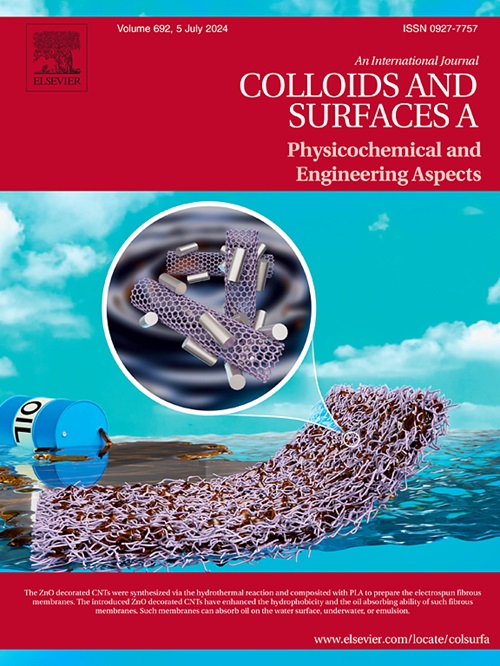In vitro and in vivo evaluation of graphene oxide–gold nanocomposites for enhanced biocompatibility and functional performance in biomaterial application
IF 4.9
2区 化学
Q2 CHEMISTRY, PHYSICAL
Colloids and Surfaces A: Physicochemical and Engineering Aspects
Pub Date : 2025-07-10
DOI:10.1016/j.colsurfa.2025.137721
引用次数: 0
Abstract
Gold-functionalized graphene oxide (GO-Au) nanocomposites were synthesized and comprehensively characterized to assess their physicochemical properties and biomedical efficacy. UV-Vis spectroscopy revealed a distinct surface plasmon resonance peak at ∼524 nm, confirming successful Au nanoparticle (AuNP) incorporation. FTIR analysis showed shifts in O–H and C![]() O vibrational bands, indicating interactions between AuNPs and the oxygen-containing groups on GO. Among all tested formulations, GO-Au at 12.2 ppm exhibited optimal morphology, the highest antioxidant activity (92 % DPPH radical scavenging), and improved hydrophilicity. 1 H NMR spectroscopy demonstrated a reduction in signal intensity within the 1.45–2.13 ppm range, suggesting selective interactions between AuNPs and aliphatic oxygenated groups, while preserving the aromatic regions of GO. XPS analysis confirmed the presence of Au through Au 4 f peaks at 84 eV, along with characteristic C 1 s, O 1 s, and N 1 s signals. No Au peaks were observed in pristine GO. In vitro, GO-Au 12.2 ppm significantly enhanced bovine aortic endothelial cell (BAEC) proliferation at 24, 48, and 72 h (1.15, 1.27-, and 1.43-fold; p < 0.001) and promoted migration (2.32- and 3.45-fold at 24 and 48 h), accompanied by elevated MMP-2 (1.58-fold) and MMP-9 (1.49-fold) activity. In contrast, Raw 264.7 macrophages showed marked reductions in viability (0.60-, 0.55-, and 0.63-fold) and pro-inflammatory cytokine secretion (TNF-α, IL-1β, IL-6; all p < 0.001), indicating potent anti-inflammatory effects. GO-Au 12.2 ppm also facilitated mesenchymal stem cell (MSC) differentiation, significantly increasing expression of endothelial markers CD31 (1.76-fold) and vWF (1.53-fold), as well as neural markers nestin (1.62-fold), GFAP (1.78-fold), and β-tubulin (2.03-fold; all p < 0.001). In vivo, subcutaneous implantation of GO-Au 12.2 ppm in rats for 4 weeks demonstrated reduced fibrous capsule thickness (0.72-fold), collagen deposition (0.69-fold), and apoptosis (0.65-fold; p < 0.01). Immunofluorescence revealed increased CD31 (1.86-fold), decreased CD45 (0.58-fold) and CD86 (0.49-fold), and elevated CD163 (1.70-fold), reflecting enhanced angiogenesis and an anti-inflammatory microenvironment. Collectively, these findings establish GO-Au 12.2 ppm as a promising nanoplatform with superior cytocompatibility, immunomodulatory function, and regenerative efficacy, supporting its potential in tissue engineering and regenerative medicine.
O vibrational bands, indicating interactions between AuNPs and the oxygen-containing groups on GO. Among all tested formulations, GO-Au at 12.2 ppm exhibited optimal morphology, the highest antioxidant activity (92 % DPPH radical scavenging), and improved hydrophilicity. 1 H NMR spectroscopy demonstrated a reduction in signal intensity within the 1.45–2.13 ppm range, suggesting selective interactions between AuNPs and aliphatic oxygenated groups, while preserving the aromatic regions of GO. XPS analysis confirmed the presence of Au through Au 4 f peaks at 84 eV, along with characteristic C 1 s, O 1 s, and N 1 s signals. No Au peaks were observed in pristine GO. In vitro, GO-Au 12.2 ppm significantly enhanced bovine aortic endothelial cell (BAEC) proliferation at 24, 48, and 72 h (1.15, 1.27-, and 1.43-fold; p < 0.001) and promoted migration (2.32- and 3.45-fold at 24 and 48 h), accompanied by elevated MMP-2 (1.58-fold) and MMP-9 (1.49-fold) activity. In contrast, Raw 264.7 macrophages showed marked reductions in viability (0.60-, 0.55-, and 0.63-fold) and pro-inflammatory cytokine secretion (TNF-α, IL-1β, IL-6; all p < 0.001), indicating potent anti-inflammatory effects. GO-Au 12.2 ppm also facilitated mesenchymal stem cell (MSC) differentiation, significantly increasing expression of endothelial markers CD31 (1.76-fold) and vWF (1.53-fold), as well as neural markers nestin (1.62-fold), GFAP (1.78-fold), and β-tubulin (2.03-fold; all p < 0.001). In vivo, subcutaneous implantation of GO-Au 12.2 ppm in rats for 4 weeks demonstrated reduced fibrous capsule thickness (0.72-fold), collagen deposition (0.69-fold), and apoptosis (0.65-fold; p < 0.01). Immunofluorescence revealed increased CD31 (1.86-fold), decreased CD45 (0.58-fold) and CD86 (0.49-fold), and elevated CD163 (1.70-fold), reflecting enhanced angiogenesis and an anti-inflammatory microenvironment. Collectively, these findings establish GO-Au 12.2 ppm as a promising nanoplatform with superior cytocompatibility, immunomodulatory function, and regenerative efficacy, supporting its potential in tissue engineering and regenerative medicine.
体外和体内评价氧化石墨烯-金纳米复合材料在生物材料应用中的生物相容性和功能性能
合成了金功能化氧化石墨烯(GO-Au)纳米复合材料,并对其物理化学性质和生物医学功效进行了综合表征。紫外可见光谱显示在~ 524 nm处有明显的表面等离子体共振峰,证实了Au纳米颗粒(AuNP)的成功结合。FTIR分析显示,O-H和CO的振动带发生了变化,表明AuNPs与氧化石墨烯上的含氧基团之间存在相互作用。在所有测试的配方中,12.2 ppm的GO-Au表现出最佳的形态,最高的抗氧化活性(92 %的DPPH自由基清除),并改善了亲水性。1 H NMR谱显示在1.45-2.13 ppm范围内信号强度降低,表明AuNPs与脂肪族氧化基团之间存在选择性相互作用,同时保留了氧化石墨烯的芳香区。XPS分析证实了Au的存在,通过Au 4 f峰在84 eV,以及特征c1 s, O 1 s和n1 s信号。原始氧化石墨烯中未观察到Au峰。在体外,GO-Au 12.2 ppm在24、48和72 h时显著增强牛主动脉内皮细胞(BAEC)的增殖(1.15、1.27和1.43倍);p & lt;0.001),并促进迁移(在24和48 h时分别为2.32和3.45倍),同时MMP-2(1.58倍)和MMP-9(1.49倍)活性升高。相比之下,Raw 264.7巨噬细胞的活力明显降低(0.60-,0.55-和0.63倍),促炎细胞因子分泌(TNF-α, IL-1β, IL-6;所有p <;0.001),表明有效的抗炎作用。GO-Au 12.2 ppm还促进间充质干细胞(MSC)分化,显著增加内皮标志物CD31(1.76倍)和vWF(1.53倍)的表达,以及神经标志物巢蛋白(1.62倍)、GFAP(1.78倍)和β-微管蛋白(2.03倍)的表达;所有p <;0.001)。在体内,大鼠皮下植入12.2 ppm的GO-Au 4周后,纤维囊厚度减少(0.72倍),胶原沉积减少(0.69倍),细胞凋亡减少(0.65倍);p & lt;0.01)。免疫荧光显示CD31(1.86倍)升高,CD45(0.58倍)和CD86(0.49倍)降低,CD163(1.70倍)升高,反映血管生成增强和抗炎微环境。总的来说,这些发现表明GO-Au 12.2 ppm是一种有前途的纳米平台,具有优越的细胞相容性、免疫调节功能和再生功效,支持其在组织工程和再生医学中的潜力。
本文章由计算机程序翻译,如有差异,请以英文原文为准。
求助全文
约1分钟内获得全文
求助全文
来源期刊
CiteScore
8.70
自引率
9.60%
发文量
2421
审稿时长
56 days
期刊介绍:
Colloids and Surfaces A: Physicochemical and Engineering Aspects is an international journal devoted to the science underlying applications of colloids and interfacial phenomena.
The journal aims at publishing high quality research papers featuring new materials or new insights into the role of colloid and interface science in (for example) food, energy, minerals processing, pharmaceuticals or the environment.

 求助内容:
求助内容: 应助结果提醒方式:
应助结果提醒方式:


